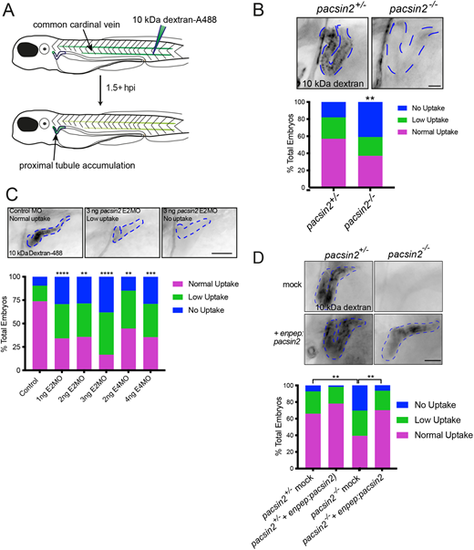Fig. 3
- ID
- ZDB-FIG-220629-3
- Publication
- Morgan et al., 2022 - Pacsin2 is required for endocytosis in the zebrafish pronephric tubule
- Other Figures
- All Figure Page
- Back to All Figure Page
|
Depletion or knockout of Pacsin2 in zebrafish larvae impairs renal tubule endocytosis. (A) Schematic representation of dextran reabsorption assay performed on zebrafish larvae. (B) Top, representative image of 4?dpf pacsin2+/? (left) and pacsin2?/? (right) larvae 1.5?h post-injection with 10?kDa dextran-A488, displaying normal and no uptake phenotypes, respectively. Scale bar: 25?Ám. The blue dashed line indicates the position of the proximal tubule. Bottom, the percentage of larvae showing normal, low or no uptake phenotypes in pacsin 2+/? and pacsin 2?/? larvae. Data were analysed using a Chi-squared test. **P<0.01. n=67 (pacsin2+/?) and 41 (pacsin2?/?). (C) Top, representative images of 3?dpf control larvae showing normal accumulation of 10?kDa dextran-A488 at 1.5?h post-injection and morphant embryos displaying low or no uptake phenotypes, respectively. The blue dashed lines outline the position of the proximal tubule. Scale bar: 50?Ám. Bottom, quantification of uptake phenotypes of control, E2MO and E4MO morphant larvae. Data were analysed using a Chi-squared test. **P<0.01, ***P<0.001, ****P<0.0001. n=28-84 larvae per genotype. (D) Top, representative images of cmlc:GFP (top row, mock) and enpep:pacsin2 (bottom row) rescued pacsin2+/? and pacsin2?/? larvae. The blue dashed lines outline the proximal tubule. Scale bar: 60?Ám. Bottom, percentage of total larvae scored for uptake phenotypes. Data were analysed using a Chi-squared test. **P<0.01. n=23-56 larvae per genotype. |
| Fish: | |
|---|---|
| Knockdown Reagents: | |
| Observed In: | |
| Stage: | Day 4 |

